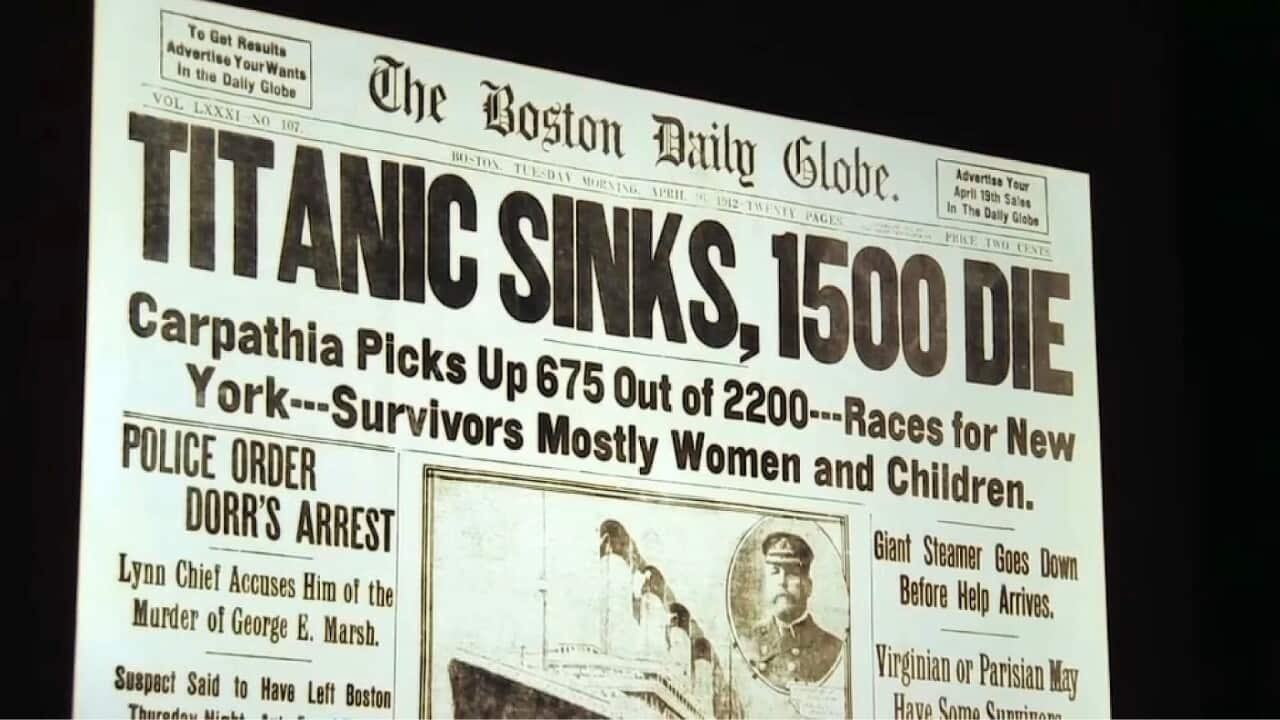Italian
“Titanic la mostra” rinfresca la memoria sulla tragedia dello sventurato transatlantico, che affondò nel 1912 durante la sua prima traversata.
Da un abito indossato da un superstite nella notte in cui il Titanic affondò, alle stoviglie recuperate dall’area della prima classe - queste sono tutte reliquie importanti del relitto più famoso del mondo.
Fanno parte di una nuova coinvolgente mostra inaugurata a Londra, che accende i riflettori sulle vite perdute a bordo della sfortunato nave di linea.
Il Titanic era la nave più grande del suo tempo, ed era considerata inaffondabile.
Ma mentre stava viaggiando da Southampton a New York nell’aprile del 1912, colpì un iceberg ed affondò.
Parlando nel 1985 al canale canadese CBC, una delle superstiti, Eva Hart, disse che i suoi ricordi di quella notte erano molto vividi.
"My mother awakened me and my father took me, went with my mother, and took me and placed me in the lifeboat and my mother and made no attempt to get in herself. Because I really do owe the good fortune of my living to the fact that my mother had a tremendous premonition of disaster from the first time that she knew she was getting on the Titanic. And she said that to say that the ship was unsinkable, which is what the whole world was saying, to say that was flying in the face of God."
Hart ha raccontato che mentre guardava la nave affondare poteva vedere l’iceberg.
"It was a terribly dark night. Starlit but no moonlight, and this tremendous ship which didn't sink for over two hours. Horrible sight. Dreadful sight. As we rode away and we looked back at the ship, we could see the iceberg, so to speak behind it. That's the only way I can describe it. It was very large."
Più di un secolo dopo, questa mostra è la prova del fascino duraturo di una tragedia che da allora ha ispirato film, musical a libri.
La mostra comprende più di 200 oggetti provenienti dal Titanic.
Tra i reperti visibili, ci sono delle ricostruzioni in scala integrale degli interni della nave, incluso un corridoio di prima classe che i visitatori possono percorrere, apprezzando l’enorme differenza tra la prima e la terza classe.
Molte storie legate al Titanic sono state riportate a galla dalla mostra.
Tra le storie, c’è quella di Victor Peñasco, un ricco passeggero spagnolo che fece salire la sua novella sposa e la loro domestica sulla scialuppa di salvataggio numero 8, prima di ritirarsi sulla nave che affondava per aiutare altre persone- per poi scomparire per sempre.
Nella mostra si può vedere lo smoking del signor Peñasco; il suo corpo non è mai stato identificato e potrebbe non essere mai stato ritrovato.
Luis Ferreiro, a capo della compagnia che ha allestito la mostra, sottolinea il fatto che la mostra rende giustizia alla memoria di coloro che morirono nell’incidente.
"I would say, that this is actually a very museum (-like) exhibition in many ways, because, of course, we have original artefacts, we have original stories, and it has been created by a team of professionals from the museum community. So actually, what we think is that people will be able to really understand better the story of the Titanic, and hopefully confront many myths and legends, misconceptions that we have from the story and actually be confronted by the authentic story, through real artefacts and real stories."
Ma Eva Hart, parlando nel 1985, ha raccontato che la vera eredità del Titanic fu che le misure di sicurezza vennero migliorate per salvaguardare la sicurezza dei passeggeri a bordo dei transatlantici.
"I know what the fault was. The fault was that that ship was allowed to go to sea with too few lifeboats. And therefore those 1513 people who died that night need not have died. And it took a disaster like that to make the Board of Trade* alter their regulations, which now says of course that you cannot go to see without you taking enough lifeboats for everyone. But it took a disaster like that to bring that into being."
Eva Hart, una degli ultimi superstiti del Titanic ad essere sopravvissuta, è morta nel 1996 all’età di 91 anni.
La mostra durerà fino alla primavera dell’emisfero nord del 2022- ma è probabile che la storia tragica della nave continuerà a catturare l’immaginazione del pubblico negli anni a venire.
English
"Titanic The Exhibition" is taking a fresh look at the tragedy of the ill-fated ocean liner, which sank in 1912 on its maiden voyage.
From a night gown worn by a survivor on the night the ocean liner sank, to crockery found in its first-class section - these are all poignant relics of the world's best-known shipwreck.
They form part of a new, immersive exhibit that's opened in London that casts light on the lives that were lost on the ill-fated liner.
The Titanic was the grandest ship of its time and was thought to be unsinkable.
But while travelling from Southampton to New York in April 1912, it hit an iceberg and sank.
Speaking in 1985 to Canadian broadcaster CBC, one of the survivors of the disaster, Eva Hart, said her memories of that night are very clear.
"My mother awakened me and my father took me, went with my mother, and took me and placed me in the lifeboat and my mother and made no attempt to get in herself. Because I really do owe the good fortune of my living to the fact that my mother had a tremendous premonition of disaster from the first time that she knew she was getting on the Titanic. And she said that to say that the ship was unsinkable, which is what the whole world was saying, to say that was flying in the face of God."
Ms Hart says as she looked back towards the sinking ship from her lifeboat, she could see the iceberg itself.
"It was a terribly dark night. Starlit but no moonlight, and this tremendous ship which didn't sink for over two hours. Horrible sight. Dreadful sight. As we rode away and we looked back at the ship, we could see the iceberg, so to speak behind it. That's the only way I can describe it. It was very large."
More than a century later, Titanic the Exhibition is testament to the enduring appeal of a tragedy that's inspired films, musicals and books ever since.
The exhibition consists of more than 200 items from the Titanic.
Among the exhibits on display are life-size recreations of the ship's interior, including a first-class corridor that visitors can walk through and experience the gulf between first and third-class passengers.
Many Titanic stories are being brought to life by the exhibition.
The stories include that of Victor Peñasco, a wealthy Spanish passenger who ushered his new bride and their maid into lifeboat number eight, before retreating to the sinking ship to help others - never to be seen again.
Mr Peñasco's tuxedo is on display in the exhibit; his body was never identified and may not have been recovered.
Luis Ferreiro, the CEO of the company putting the exhibition on, insists it does justice to the memories of those who died in the disaster.
"I would say, that this is actually a very museum (-like) exhibition in many ways, because, of course, we have original artefacts, we have original stories, and it has been created by a team of professionals from the museum community. So actually, what we think is that people will be able to really understand better the story of the Titanic, and hopefully confront many myths and legends, misconceptions that we have from the story and actually be confronted by the authentic story, through real artefacts and real stories."
But Eva Hart, speaking back in 1985, says the true legacy of the Titanic was that safety standards were raised to ensure the safety of all aboard passenger liners.
"I know what the fault was. The fault was that that ship was allowed to go to sea with too few lifeboats. And therefore those 1513 people who died that night need not have died. And it took a disaster like that to make the Board of Trade* alter their regulations, which now says of course that you cannot go to see without you taking enough lifeboats for everyone. But it took a disaster like that to bring that into being."
Eva Hart, one of the last remaining survivors of the Titanic disaster, died in 1996 at the age of 91.
The exhibition runs through to the northern Spring of 2022 - but it's likely the ship's tragic tale will continue to capture the public's imagination for years to come.
Report by Allan Lee.




